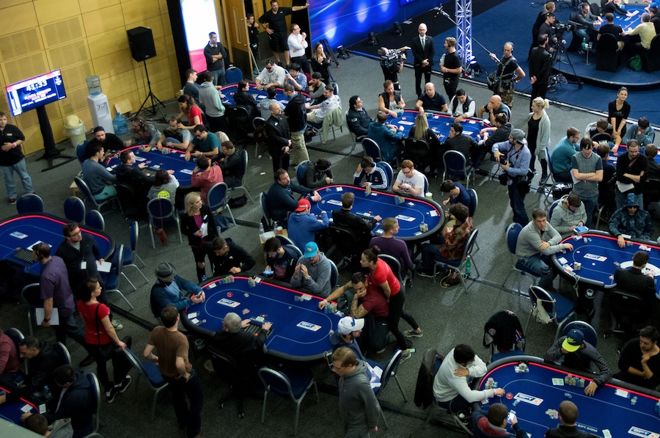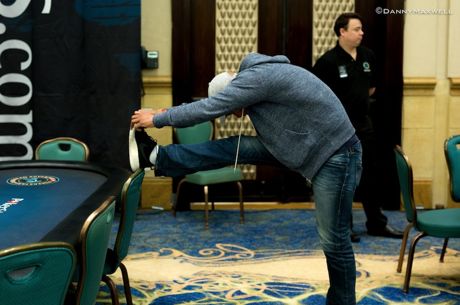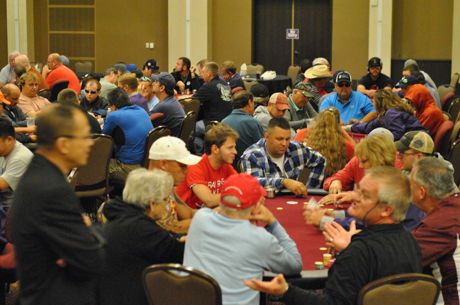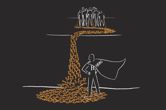10 Multi-Table Tournament Tips: Approaching the Bubble

You're continuing to make your way through a multi-table tournament, having survived the early levels and most of the middle stage. Now you're close enough to the money that the prospect of cashing is starting to seem increasingly likely. Perhaps it's even creeping into your thinking as you approach individual hands �� and you're noticing the same thing happening with other players, too.
Let's talk today about MTT strategy when nearing the money but not yet at the stage when the next elimination (or several eliminations) will burst the bubble. For instance, if the top 15 percent of finishers make the cash, let's try to focus on that period beginning when roughly twice that many players are remaining �� that is, a little less than a third of the starting field.
In other words, as you look around the tournament room --or scan the lobby if you're playing poker online -- you can say roughly half the players who are left are going to make the money, while the other half will be going away empty-handed. It's a 300-player tournament (for instance), and the top 45 players are cashing. How should you be altering your approach once the field is down to 90 players and as it continues to be whittled down further to 55 or so?
In our discussion of middle stage strategy, we focused largely on stack sizes, talking about how both your own stack and the stacks of your opponents should affect your strategy. Each of those suggestions regarding big stacks, medium stacks, and short stacks continue to be worth following during this "approaching the bubble" stage, which in many respects is still the "middle stage" of the tournament.
To that advice, though, let's add a few more specific suggestions regarding things to think about during this pre-bubble period.
1. Approaching the Bubble: Recognize Who Is Getting Tight
The pre-bubble is an interesting "in-between" period. Theoretically, everyone still has the same options available to them they enjoyed before the tournament reached that stage.
The big stacks can still steal and resteal, try to trap and stack opponents, pressure medium stacks, and take judicious gambles versus short ones. The medium stacks can also target short stacks' blinds, value bet strong hands, steer clear of being trapped by big stacks, and play smart position poker. And the short stacks likewise can look for double-up opportunities and even ways to chip up without going all in (unless they've dipped down to that 6-8 big blind danger zone).
That said, there will be players in all three categories who gradually �� or all at once �� remove various moves from their arsenal once the pre-bubble stage arrives. Those who were preflop three-bettors no longer are. Those who had defended their blinds with calls and reraises start giving them up without resistance. Those who were getting involved from any position restrict themselves only to late-position opens, if that. Meanwhile the already-tight players grow even tighter.
When the tournament hits that stage when less than a third of the field is left, start paying attention to those at your table who may be slipping into this category of "partial paralysis." Even big stacks sometimes exhibit a tendency to "turtle" up and hide in their shells, although usually not as conspicuously as happens with medium and shorter stacks.
Meanwhile, also take note of players who do not appear so restrained and seem still to be utilizing all the tools available to them given their current stacks. In lower buy-in events such players may be the exception, while in higher buy-in events with stronger fields they may make up the majority.
2. Approaching the Bubble: Take the Initiative (Be "First")
Having identified who's tightening up,finding ways to target those players is a logical and potentially profitable response. By the same token, it makes sense as well to be wary of mixing it up with those who aren't shifting into a lower, tighter gear.
However, even if you can't readily segregate your opponents into these two groups, the pre-bubble period is one where having the initiative whenever you enter pots is often going to be the recommended course. That means opening good starters and continuation betting more often, value betting strong and medium strength hands, not slow playing your monsters, and generally leaning toward being "first" with bets when it comes to fighting for chips.
This doesn't mean being blindly aggressive. You're still being selective about hands, situations, and opponents (when possible). But since it is often the case that the medium and short stacks especially are increasingly going to play hands relatively straightforwardly �� even reverting entirely to "fit or fold" or "A-B-C" poker �� taking the lead in hands either before or after the flop is more often than not going to win you chips while avoiding showdowns.
You can even set up postflop aggression with a passive line preflop �� say, by calling a raise from position or even limping behind in multi-way pots, then firing on the flop when no one else is showing strength. Passive players not wanting to risk chips will result in many so-called "orphaned pots" for players willing to take them.
3. Approaching the Bubble: Avoid Unnecessary Risks
As the previous points suggest, being overly tight or passive during the pre-bubble stage generally won't help position you well when the bubble does finally arrive. It could even result in your getting worn down to the point of needing that last double-up in order to make the cash at all.
There is a difference, though, between opening up your game and smartly looking for spots to chip up and being reckless during such an important part of the tournament. Common mistakes made throughout tournaments become magnified in their importance during the pre-bubble stage �� mistakes like calling raises from out of position with marginal or speculative hands, chasing draws with poor pot odds, or not folding after conspicuous shows of strength like check-raises or all-in shoves.
Regarding the latter, players with big and medium stacks will sometimes be a little too ready to call all-ins from short stacks during this period, unnecessarily losing significant percentages of their chips as a result. This happens sometimes just after a player has won a pot, then on the next hand responds to an invitation to gamble once more as though it were one of those poker freerolls. "Why not?" the player thinks. Because the pressure of the bubble hasn't fully arrived, thoughts of not cashing or not preserving enough chips to make the final table aren't foremost in the player's mind. Thus might the player go ahead and call an eight BB-shove with hands like A?6?, 3?3?, or K?10?.
Then the bubble stage really arrives, and after losing one or two of those all-ins the big stacks find they've become medium stacks, or the medium stacks are suddenly short.
Understand that the value of eliminating a single player is still relatively minimal to you when the tournament is two or three tables away from the money �� much less than earning a knockout once the bubble has burst or especially during the "endgame" when down to the last two tables. During this pre-bubble stage, think twice before calling those short-stack shoves that seem harmless but can greatly damage your chances of making a deep run.
Conclusion
A rule of thumb for multi-table tournaments followed by many players is to play tight during the early levels, loosen up once the antes kick in, then when the bubble nears to become conservative again until reaching the money.
This works as a general approach, but it's most important to understand the need to change your style in response both to changes in stack sizes (your own and your opponents') as well as in response to how the players at your particular table are playing.
When moving through these last levels before getting just a few eliminations from the money, pay close attention to who is tightening up, look for chances to accumulate chips through value betting and pushing tentative players off hands, and don't be overly reckless and put yourself in high-risk spots like playing from out of position or being the one giving the short stacks "courtesy double-ups."
Also in this series...
- Fast vs. Slow Structures
- The Importance of Stack Sizes
- Chip Accumulation vs. Survival
- How to Play the Early Levels
- Middle Stage Strategy
- Strategy on the Bubble
- In the Money
- Going for the Win
- Bankroll Management for Poker MTTs
Ready to take a seat at the table? Put these multi-table tournament tips into practice at 888poker.
In this Series
- 1 10 Multi-Table Tournament Tips: Fast vs. Slow Structures
- 2 10 Multi-Table Tournament Tips: The Importance of Stack Sizes
- 3 10 Multi-Table Tournament Tips: Chip Accumulation vs. Survival
- 4 10 Multi-Table Tournament Tips: How to Play the Early Levels
- 5 10 Multi-Table Tournament Tips: Middle Stage Strategy
- 6 10 Multi-Table Tournament Tips: Approaching the Bubble
- 7 10 Multi-Table Tournament Tips: Strategy on the Bubble
- 8 10 Multi-Table Tournament Tips: In the Money
- 9 10 Multi-Table Tournament Tips: Going for the Win
- 10 10 Multi-Table Tournament Tips: Bankroll Management









